 W
WDigital electronics is a field of electronics involving the study of digital signals and the engineering of devices that use or produce them. This is in contrast to analog electronics and analog signals.
 W
WThe 4000 series is a CMOS logic family of integrated circuits (ICs) first introduced in 1968 by RCA. Almost all IC manufacturers active during this initial era fabricated models for this series. It is still in use today.
 W
WThe 7400 series of integrated circuits (ICs) were one of the most popular logic families of transistor–transistor logic (TTL) logic chips. In 1964, Texas Instruments introduced the first members of their ceramic semiconductor package series, the SN5400s. A low-cost plastic package SN7400 series was introduced in 1966 which quickly gained over 50% of the logic chip market, and eventually becoming de facto standardized electronic components. Over the decades, many generations of pin-compatible descendant families evolved to include support for low power CMOS technology, lower supply voltages, and surface mount packages.
 W
WThe Additron was an electron tube designed by Dr. Josef Kates, circa 1950, to replace the several individual electron tubes and support components required to perform the function of a single bit digital full adder. Dr. Kates developed the Additron with the intention of increasing the likelihood of success and reliability while reducing the size, power consumption and complexity of the University of Toronto Electronic Computer, (UTEC)
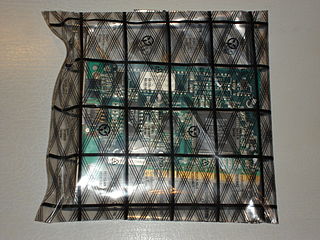 W
WAn antistatic bag is a bag used for storing electronic components, which are prone to damage caused by electrostatic discharge (ESD).
 W
WAn antistatic device is any device that reduces, dampens, or otherwise inhibits electrostatic discharge, or ESD, which is the buildup or discharge of static electricity. ESD can damage electrical components such as computer hard drives, and even ignite flammable liquids and gases.
 W
WA behavior tree is a mathematical model of plan execution used in computer science, robotics, control systems and video games. They describe switchings between a finite set of tasks in a modular fashion. Their strength comes from their ability to create very complex tasks composed of simple tasks, without worrying how the simple tasks are implemented. Behavior trees present some similarities to hierarchical state machines with the key difference that the main building block of a behavior is a task rather than a state. Its ease of human understanding make behavior trees less error prone and very popular in the game developer community. Behavior trees have been shown to generalize several other control architectures. Mathematically, they are directed acyclic graphs.
 W
WBeyond CMOS refers to the possible future digital logic technologies beyond the CMOS scaling limits which limits device density and speeds due to heating effects.
 W
WIn a dynamical system, bistability means the system has two stable equilibrium states. Something that is bistable can be resting in either of two states. An example of a mechanical device which is bistable is a light switch. The switch lever is designed to rest in the "on" or "off" position, but not between the two. Bistable behavior can occur in mechanical linkages, electronic circuits, nonlinear optical systems, chemical reactions, and physiological and biological systems.
 W
WIn computer architecture, a bus is a communication system that transfers data between components inside a computer, or between computers. This expression covers all related hardware components and software, including communication protocols.
 W
WA bus analyzer is a type of a protocol analysis tool, used for capturing and analyzing communication data across a specific interface bus, usually embedded in a hardware system. The bus analyzer functionality helps design, test and validation engineers to check, test, debug and validate their designs throughout the design cycles of a hardware-based product. It also helps in later phases of a product life cycle, in examining communication interoperability between systems and between components, and clarifying hardware support concerns.
 W
WThe Muller C-element is a small digital block widely used in design of asynchronous circuits and systems. It has been specified formally in 1955 by David E. Muller and first used in ILLIAC II computer. In terms of the theory of lattices, the C-element is a semimodular distributive circuit, whose operation in time is described by a Hasse diagram. The C-element is closely related to the rendezvous and join elements, where an input is not allowed to change twice in succession. In some cases, when relations between delays are known, the C-element can be realized as a sum-of-product (SOP) circuit. Earlier techniques for implementing the C-element include Schmidt trigger, Eccles-Jordan flip-flop and last moving point flip-flop.
 W
WA channel router is a specific variety of router for integrated circuits. Normally using two layers of interconnect, it must connect the specified pins on the top and bottom of the channel. Specified nets must also be brought out to the left and right of the channel, but may be brought out in any order. The height of the channel is not specified - the router computes what height is needed.
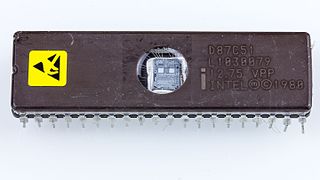 W
WCHMOS refers to one of a series of Intel CMOS processes developed from their HMOS process..
 W
WComplementary metal–oxide–semiconductor (CMOS), also known as complementary-symmetry metal–oxide–semiconductor (COS-MOS), is a type of metal–oxide–semiconductor field-effect transistor (MOSFET) fabrication process that uses complementary and symmetrical pairs of p-type and n-type MOSFETs for logic functions. CMOS technology is used for constructing integrated circuit (IC) chips, including microprocessors, microcontrollers, memory chips, and other digital logic circuits. CMOS technology is also used for analog circuits such as image sensors, data converters, RF circuits, and highly integrated transceivers for many types of communication.
 W
WIn automata theory, combinational logic is a type of digital logic which is implemented by Boolean circuits, where the output is a pure function of the present input only. This is in contrast to sequential logic, in which the output depends not only on the present input but also on the history of the input. In other words, sequential logic has memory while combinational logic does not.
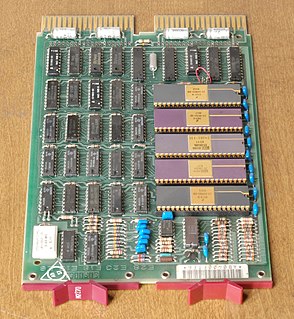 W
WComputer hardware includes the physical parts of a computer, such as the case, central processing unit (CPU), monitor, mouse, keyboard, computer data storage, graphics card, sound card, speakers and motherboard.
 W
WIn computing, memory refers to a device that is used to store information for immediate use in a computer or related computer hardware device. It typically refers to semiconductor memory, specifically metal–oxide–semiconductor (MOS) memory, where data is stored within MOS memory cells on a silicon integrated circuit chip. The term "memory" is often synonymous with the term "primary storage". Computer memory operates at a high speed, for example random-access memory (RAM), as a distinction from storage that provides slow-to-access information but offers higher capacities. If needed, contents of the computer memory can be transferred to secondary storage; a very common way of doing this is through a memory management technique called virtual memory. An archaic synonym for memory is store.
 W
WDatabending is the process of manipulating a media file of a certain format, using software designed to edit files of another format. Distortions in the medium typically occur as a result, and the process either falls under a broader category of, or is frequently employed in glitch art.
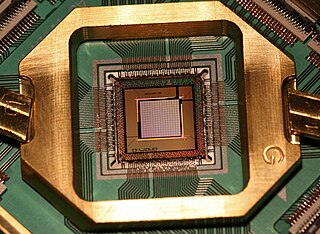 W
WThe Josephson junction count is the number of Josephson junctions on a superconducting integrated circuit chip. Josephson junctions are active circuit elements in superconducting circuits. The Josephson junction count is a measure of circuit or device complexity, similar to the transistor count used for semiconductor integrated circuits.
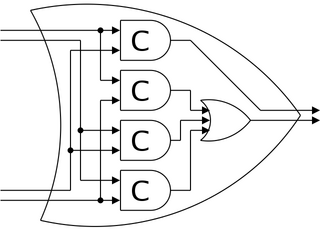 W
WThe DIMS system is an asynchronous design methodology making the least possible timing assumptions. Assuming only the quasi-delay-insensitive delay model the generated designs need little if any timing hazard testing. The basis for DIMS is the use of two wires to represent each bit of data. This is known as a dual-rail data encoding. Parts of the system communicate using the early four-phase asynchronous protocol.
 W
WIn electronics, a delay-locked loop (DLL) is a digital circuit similar to a phase-locked loop (PLL), with the main difference being the absence of an internal voltage-controlled oscillator, replaced by a delay line.
 W
WDesign for manufacturability is the general engineering practice of designing products in such a way that they are easy to manufacture. The concept exists in almost all engineering disciplines, but the implementation differs widely depending on the manufacturing technology. DFM describes the process of designing or engineering a product in order to facilitate the manufacturing process in order to reduce its manufacturing costs. DFM will allow potential problems to be fixed in the design phase which is the least expensive place to address them. Other factors may affect the manufacturability such as the type of raw material, the form of the raw material, dimensional tolerances, and secondary processing such as finishing.
 W
WDirect-coupled transistor logic (DCTL) is similar to resistor–transistor logic (RTL) but the input transistor bases are connected directly to the collector outputs without any base resistors. Consequently, DCTL gates have fewer components, are more economical, and are simpler to fabricate onto integrated circuits than RTL gates. Unfortunately, DCTL has much smaller signal levels, has more susceptibility to ground noise, and requires matched transistor characteristics. The transistors are also heavily overdriven; that is a good feature in that it reduces the saturation voltage of the output transistors, but it also slows the circuit down due to a high stored charge in the base. Gate fan-out is limited due to "current hogging": if the transistor base-emitter voltages are not well matched, then the base-emitter junction of one transistor may conduct most of the input drive current at such a low base-emitter voltage that other input transistors fail to turn on.
 W
WIn computing, a computer bus operating with double data rate (DDR) transfers data on both the rising and falling edges of the clock signal. This is also known as double pumped, dual-pumped, and double transition. The term toggle mode is used in the context of NAND flash memory.
 W
WElectrostatic discharge materials are plastics that reduce static electricity to protect electrostatic-sensitive devices (ESD) or contain flammable liquids or gases.
 W
WAn encoder in digital electronics is a one-hot to binary converter. That is, if there are 2n input lines, and at most only one of them will ever be high, the binary code of this 'hot' line is produced on the n-bit output lines. A binary encoder is the dual of a binary decoder.
 W
WIn electronics, a flip-flop or latch is a circuit that has two stable states and can be used to store state information – a bistable multivibrator. The circuit can be made to change state by signals applied to one or more control inputs and will have one or two outputs. It is the basic storage element in sequential logic. Flip-flops and latches are fundamental building blocks of digital electronics systems used in computers, communications, and many other types of systems.
 W
WA frequency counter is an electronic instrument, or component of one, that is used for measuring frequency. Frequency counters usually measure the number of cycles of oscillation, or pulses per second in a periodic electronic signal. Such an instrument is sometimes referred to as a cymometer, particularly one of Chinese manufacture.
 W
WGlitch art is the practice of using digital or analog errors for aesthetic purposes by either corrupting digital data or physically manipulating electronic devices. Glitches appear in visual art such as the film A Colour Box (1935) by Len Lye, the video sculpture TV Magnet (1965) by Nam June Paik and more contemporary work such as Panasonic TH-42PWD8UK Plasma Screen Burn (2007) by Cory Arcangel.
Glitch removal is the elimination of glitches—unnecessary signal transitions without functionality—from electronic circuits. Power dissipation of a gate occurs in two ways: static power dissipation and dynamic power dissipation. Glitch power comes under dynamic dissipation in the circuit and is directly proportional to switching activity. Glitch power dissipation is 20%-70% of total power dissipation and hence glitching should be eliminated for low power design.
 W
WIn-system programming (ISP), also called in-circuit serial programming (ICSP), is the ability of some programmable logic devices, microcontrollers, and other embedded devices to be programmed while installed in a complete system, rather than requiring the chip to be programmed prior to installing it into the system. It allows firmware updates to be delivered to the on-chip memory of microcontrollers and related processors without requiring specialist programming circuitry on the circuit board, and simplifies design work.
 W
WAn integrated circuit or monolithic integrated circuit is a set of electronic circuits on one small flat piece of semiconductor material that is normally silicon. The integration of large numbers of tiny MOS transistors into a small chip results in circuits that are orders of magnitude smaller, faster, and less expensive than those constructed of discrete electronic components. The IC's mass production capability, reliability, and building-block approach to integrated circuit design has ensured the rapid adoption of standardized ICs in place of designs using discrete transistors. ICs are now used in virtually all electronic equipment and have revolutionized the world of electronics. Computers, mobile phones, and other digital home appliances are now inextricable parts of the structure of modern societies, made possible by the small size and low cost of ICs.
The FS5000 Jitterlyzer performs physical layer serial bus jitter evaluation. It can inject controlled jitter and measure the characteristics of incoming jitter. When teamed with a logic analyzer or protocol analyzer, it can correlate these measurements with protocol analysis. Physical-layer tests can be performed while the system under test is processing live bus traffic.
 W
WA logic analyzer is an electronic instrument that captures and displays multiple signals from a digital system or digital circuit. A logic analyzer may convert the captured data into timing diagrams, protocol decodes, state machine traces, assembly language, or may correlate assembly with source-level software. Logic analyzers have advanced triggering capabilities, and are useful when a user needs to see the timing relationships between many signals in a digital system.
 W
WA logic probe is a low-cost hand-held test probe used for analyzing and troubleshooting the logical states of a digital circuit. When many signals need to be observed or recorded simultaneously, a logic analyzer is used instead.
 W
WThe memory cell is the fundamental building block of computer memory. The memory cell is an electronic circuit that stores one bit of binary information and it must be set to store a logic 1 and reset to store a logic 0. Its value is maintained/stored until it is changed by the set/reset process. The value in the memory cell can be accessed by reading it.
 W
WMetastability in electronics is the ability of a digital electronics system to persist for an unbounded time in an unstable equilibrium or metastable state. In digital logic circuits, a digital signal is required to be within certain voltage or current limits to represent a '0' or '1' logic level for correct circuit operation; if the signal is within a forbidden intermediate range it may cause faulty behavior in logic gates the signal is applied to. In metastable states, the circuit may be unable to settle into a stable '0' or '1' logic level within the time required for proper circuit operation. As a result, the circuit can act in unpredictable ways, and may lead to a system failure, sometimes referred to as a "glitch". Metastability is an instance of the Buridan's ass paradox.
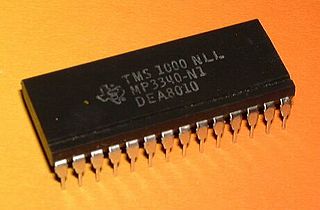 W
WA microprocessor, also simply called a processor, or CPU is a computer processor that is implemented on a single integrated circuit (IC) dies of MOSFET construction in a single package. The microprocessor is a multipurpose, clock-driven, register-based, digital integrated circuit that accepts binary data as input, processes it according to instructions stored in its memory, and provides results as output. Microprocessors contain both combinational logic and sequential digital logic. Microprocessors operate on numbers and symbols represented in the binary number system.
 W
W W
WThe metal–oxide–semiconductor field-effect transistor, also known as the metal–oxide–silicon transistor, is a type of insulated-gate field-effect transistor that is fabricated by the controlled oxidation of a semiconductor, typically silicon. The voltage of the covered gate determines the electrical conductivity of the device; this ability to change conductivity with the amount of applied voltage can be used for amplifying or switching electronic signals.
 W
WThe metal–oxide–semiconductor field-effect transistor (MOSFET, MOS-FET, or MOS FET), also known as the metal–oxide–silicon transistor (MOS transistor, or MOS), is a type of insulated-gate field-effect transistor (IGFET) that is fabricated by the controlled oxidation of a semiconductor, typically silicon. The voltage of the covered gate determines the electrical conductivity of the device; this ability to change conductivity with the amount of applied voltage can be used for amplifying or switching electronic signals. The MOSFET was invented by Egyptian engineer Mohamed M. Atalla and Korean engineer Dawon Kahng at Bell Labs in 1959. It is the basic building block of modern electronics, and the most frequently manufactured device in history, with an estimated total of 13 sextillion (1.3 × 1022) MOSFETs manufactured between 1960 and 2018.
 W
WA multiple-emitter transistor is a specialized bipolar transistor mostly used at the inputs of integrated circuit TTL NAND logic gates. Input signals are applied to the emitters. The voltage presented to the following stage is pulled low if any one or more of the base–emitter junctions is forward biased, allowing logical operations to be performed using a single transistor. Multiple-emitter transistors replace the diodes of diode–transistor logic (DTL) to make transistor–transistor logic (TTL), and thereby allow reduction of switching time and power dissipation.
 W
WNT is a digital memo recording system introduced by Sony in 1992, sometimes marketed under the name Scoopman. The system stored memos using helical scanning on special microcassettes, which were 30 × 21.5 × 5 mm with a tape width of 2.5 mm, with a recording capacity of up to 120 minutes. The Scoopmen cassettes are offered in three versions: The Sony NTC-60, -90, and -120, each describing the length of time the cassette can record.
 W
WParametron is a logic circuit element invented by Eiichi Goto in 1954. The parametron is essentially a resonant circuit with a nonlinear reactive element which oscillates at half the driving frequency. The oscillation can be made to represent a binary digit by the choice between two stationary phases π radians apart.
 W
WQuad data rate is a communication signaling technique wherein data are transmitted at four points in the clock cycle: on the rising and falling edges, and at two intermediate points between them. The intermediate points are defined by a second clock that is 90° out of phase from the first. The effect is to deliver four bits of data per signal line per clock cycle.
 W
WA Quantum Flux Parametron (QFP) is a digital logic implementation technology based on superconducting Josephson junctions. QFP's were invented by Eiichi Goto at the University of Tokyo as an improvement over his earlier parametron based digital logic technology, which did not use superconductivity effects or Josephson junctions. The Josephson junctions on QFP integrated circuits to improve speed and energy efficiency enormously over the parametrons.
 W
WIn electronics, a Schmitt trigger is a comparator circuit with hysteresis implemented by applying positive feedback to the noninverting input of a comparator or differential amplifier. It is an active circuit which converts an analog input signal to a digital output signal. The circuit is named a "trigger" because the output retains its value until the input changes sufficiently to trigger a change. In the non-inverting configuration, when the input is higher than a chosen threshold, the output is high. When the input is below a different (lower) chosen threshold the output is low, and when the input is between the two levels the output retains its value. This dual threshold action is called hysteresis and implies that the Schmitt trigger possesses memory and can act as a bistable multivibrator. There is a close relation between the two kinds of circuits: a Schmitt trigger can be converted into a latch and a latch can be converted into a Schmitt trigger.
 W
WsCMOS is a technology based on next-generation CMOS Image Sensor (CIS) design and fabrication techniques. sCMOS image sensors offer extremely low noise, rapid frame rates, wide dynamic range, high quantum efficiency, high resolution, and a large field of view simultaneously in one image.
 W
WA shift register lookup table, also shift register LUT or SRL, refers to a component in digital circuitry. It is essentially a shift register of variable length. The length of SRL is set by driving address pins high or low and can be changed dynamically, if necessary.
 W
WIn electronics, a signal edge is a transition of a digital signal from low to high or from high to low:A rising edge is the low-to-high transition. A falling edge is the high-to-low transition.
 W
WSignal integrity or SI is a set of measures of the quality of an electrical signal. In digital electronics, a stream of binary values is represented by a voltage waveform. However, digital signals are fundamentally analog in nature, and all signals are subject to effects such as noise, distortion, and loss. Over short distances and at low bit rates, a simple conductor can transmit this with sufficient fidelity. At high bit rates and over longer distances or through various mediums, various effects can degrade the electrical signal to the point where errors occur and the system or device fails. Signal integrity engineering is the task of analyzing and mitigating these effects. It is an important activity at all levels of electronics packaging and assembly, from internal connections of an integrated circuit (IC), through the package, the printed circuit board (PCB), the backplane, and inter-system connections. While there are some common themes at these various levels, there are also practical considerations, in particular the interconnect flight time versus the bit period, that cause substantial differences in the approach to signal integrity for on-chip connections versus chip-to-chip connections.
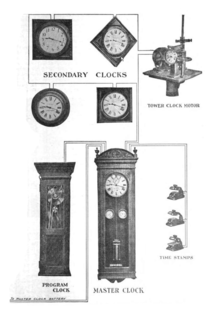 W
WIn telecommunication and horology, a slave clock is a clock that depends for its accuracy on another clock, a master clock. Many modern clocks are synchronized, either through the Internet or by radio time signals, to a worldwide time standard called Coordinated Universal Time (UTC) based on a network of master atomic clocks in many countries. For scientific purposes, precision clocks can be synchronized to within a few nanoseconds by dedicated satellite channels. Slave clock synchronization is usually achieved by phase-locking the slave clock signal to a signal received from the master clock. To adjust for the transit time of the signal from the master clock to the slave clock, the phase of the slave clock may be adjusted with respect to the signal from the master clock so that both clocks are in phase. Thus, the time markers of both clocks, at the output of the clocks, occur simultaneously.
 W
WThe STEbus is a non-proprietary, processor-independent, computer bus with 8 data lines and 20 address lines. It was popular for industrial control systems in the late 1980s and early 1990s before the ubiquitous IBM PC dominated this market.
 W
WTransistor Fault model is a Fault model used to describe faults for CMOS logic gates. At transistor level, a transistor may be stuck-short or stuck-open. In stuck-short, a transistor behaves as it is always conducts, and stuck-open is when a transistor never conducts current. Stuck-short will usually produce a short between VDD and VSS.
 W
WA voltage regulator module (VRM), sometimes called processor power module (PPM), is a buck converter that provides a microprocessor the appropriate supply voltage, converting +5 V or +12 V to a much lower voltage required by the CPU, allowing processors with different supply voltage to be mounted on the same motherboard. On personal computer (PC) systems, the VRM is typically made up of power MOSFET devices.
 W
WXilinx ISE is a discontinued software tool from Xilinx for synthesis and analysis of HDL designs, which primarily targets development of embedded firmware for Xilinx FPGA and CPLD integrated circuit (IC) product families. Use of the last released edition from October 2013 continues for in-system programming of legacy hardware designs containing older FPGAs and CPLDs otherwise orphaned by the replacement design tool, Vivado Design Suite.
 W
WVivado Design Suite is a software suite produced by Xilinx for synthesis and analysis of HDL designs, superseding Xilinx ISE with additional features for system on a chip development and high-level synthesis. Vivado represents a ground-up rewrite and re-thinking of the entire design flow.